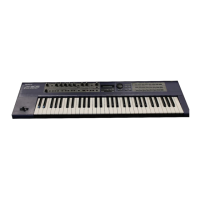Changing the Pitch Range of the
Arpeggio (Octave Range)
You can specify the pitch range in which the arpeggio
will be developed, in steps of one octave.
1. Press [ACCENT RATE/OCTAVE RANGE] to
make the button indicator light.
2. Rotate the [OCTAVE RANGE] knob to set the
Octave Range.
fig.2-47
Rotating the knob clockwise will cause the pitch range
to be extended upward from the notes which you
play. Rotating the knob counterclockwise will extend
the pitch range downward.
Selecting the Part in Dual Mode
Which Will Play the Arpeggio
(Arpeggio Destination)
When the Key Mode is set to Dual, this setting speci-
fies whether the upper and/or lower part will play
arpeggios.
1. Make sure that the [ARP] indicator is lit.
2. Hold down [DUAL] and use [LOWER]
[UPPER] to select the destination part.
If you press [LOWER] [UPPER] simultaneously, the
destination part will be "LOWER&UPPER."
fig.2-48-0
Range:
LOWER&UPPER: The patches of the upper and
lower parts will be layered to
sound the arpeggio.
LOWER: Arpeggios will be played only on
the lower part. For example, this
lets you play chords in the upper
part and arpeggios in the lower
part.
UPPER: Arpeggios will be played only on
the upper part.
Making More Detailed Settings
Normally you will create the arpeggio pattern by
adjusting the three parameters “Arpeggio Style,”
“Accent Rate,” and “Octave Range.” However by
modifying the settings of additional parameters, you
can create arpeggio patterns that are even richer in
variation.
1. Press [EDIT].
The indicator lights, and the edit page appears.
2. Press BANK [4] (ARPEGGIO).
The ARPEGGIO setting page will appear.
fig.2-48(#MC fig.5-7)
3. Use PAGE [<] [>] to select the parameter
page, and set the parameters.
To leave the setting page, press [EXIT].

